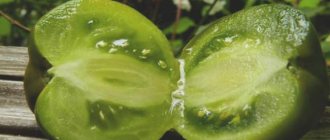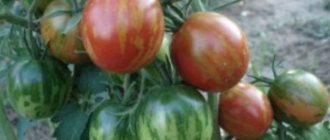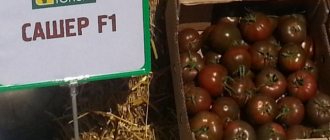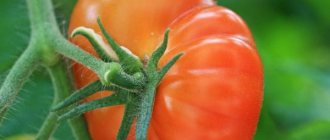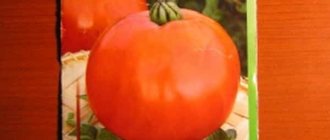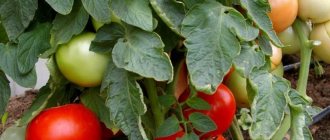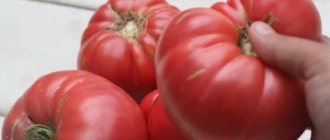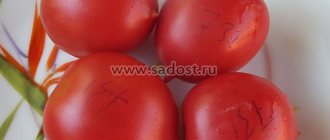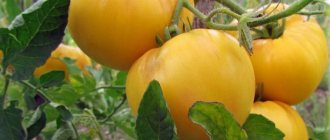The new product has an unusual appearance: color like striped tiger fur, taste with pleasant fruity notes. The fruits look incredibly beautiful when preserved. They make excellent fresh salads.
| Height | Landing location | Ripening time | Fruit color | Fruit size | Origin | Fruit shape |
| short | Greenhouse, Open ground | Early ripening | Bicolor | Average | Variety | Plum-shaped or oval |
Technical data of the Sharada tomato and rules for growing it yourself
The Sharada tomato is adapted to the climatic conditions of the northern regions. This variety was developed by German breeders. It is intended for propagation in greenhouses and open ground. In Russia, gardeners can buy seeds in St. Petersburg.
Technical data of tomato and its fruits
The characteristics and description of the Sharada variety are as follows:
- From the emergence of seedlings to the receipt of ripe fruits, 90-100 days pass.
- Tomato bushes of the described variety grow up to 100 cm in height. The average height of plants does not exceed 65-70 cm, so operations such as harvesting stepsons and tying them to trellises or supports are not necessary. The branches of the plant support the weight of the grown fruits.
- Charada tomatoes are varieties that can survive drought.
- The leaves on the bushes are small and green.
- Feedback from farmers indicates the ability of this type of plant to resist some tomato diseases.
- The fruits have the shape of an elongated plum. They are painted red. The weight of the berries ranges from 80 to 95 g. The tomato pulp is dense, the skin is quite thin.
- Inside there are 2-3 seed chambers.
The yield of Sharada tomato is 6-7 kg of fruit per 1 sq. m. bed area. They are used for canning, and whole berries are placed in jars. If you harvest the crop and put the unripe specimens in a cold place, they will ripen by late autumn, and the taste of the fruit is not lost.
Tomatoes can be cultivated throughout Russia. In the southern regions, seeds are planted directly in open ground. In the central zone of the country and the northern regions, it is recommended to use film greenhouses or greenhouse blocks for cultivating the described tomato.
How to grow tomatoes yourself?
To grow the Charada tomato, both the cultivation of the plant by seedlings and its cultivation using seed material are used.
If you decide to grow a tomato in seedlings, then sow the seeds and plant them in open ground in the third decade of March.
If there is a greenhouse or film greenhouse, the gardener can shift the indicated dates to the first ten days of March. The seeds are sown in special soil for tomatoes to a depth of 20 mm. The format for planting each seed is 8.0x8.0 or 10x10 cm. After the sprouts appear, they are picked when 1-2 leaves appear on the seedlings.
While the seedlings are growing in boxes, they are fed with humic fertilizers. This procedure must be carried out 2 or 3 times during the entire period of seedling growth. When the sprouts grow to 8-10 cm, they are hardened off and then transferred to permanent soil. This operation is performed in the last ten days of May or the first week of June.
If there is a threat of a sharp drop in temperature, then measures must be taken to protect plants from the cold.
When growing tomatoes without using seedlings, seeds are sown in the soil of a greenhouse or greenhouse in the last days of April or in the first week of May. Seeds are sown in rows in a 30x15 cm format. If cold weather is possible, it is recommended to protect them from the cold with plastic film.
When 2-3 leaves appear on the seedlings, the rows of plants are thinned out so that a format of 30x30 cm is obtained. Most often, seedlings have to be removed after one.
The method of cultivating tomatoes without seedlings makes it possible to obtain disease-resistant bushes, since they develop a tap root that goes deep, allowing the plant to collect more nutrients and moisture.
Tomato bushes must be loosened and hilled in a timely manner. As they grow, the soil under the plants is mulched using straw, grass clippings or sawdust.
Before each watering (it is carried out once a week with warm water) and loosening, the soil is enriched with complex mineral fertilizers.
At the beginning of the growing season, it is recommended to introduce more nitrogenous fertilizers into the soil. After the ovaries appear, the proportion of phosphorus and potassium mixtures is increased.
When the fruits ripen, the amount of potassium fertilizers applied to the soil is doubled. At the same time, you can feed the plants with mullein infusion or chicken droppings.
The fruits appear and ripen almost simultaneously. The bushes are resistant not only to diseases, but also resist various garden pests well.
Basic properties and productivity
Sherkhan tomatoes are an early ripening variety; the harvest can be obtained in 90-105 days. It is classified as a determinate plant: that is, it is a low-growing variety, with a maximum height of 50-60 cm.
Grows well in central and southern Russia, Moldova and Ukraine. In the northern regions, it is advisable to plant in greenhouses. Tomatoes are suitable for consumption in salads, fresh, as well as for pickling and fresh canning. The yield is about 9-10 kg per square meter.
Description of the variety has the following characteristics:
- The tomato stem is developed, the leaves are dark green, the inflorescences are simple.
- Grows well in open ground, but can also grow in greenhouses. This plant is different in that it stops growing after the formation of 4-6 clusters. If desired, it is tied to a trellis or stakes; the stepsons do not need to be removed. They are pinched in order to get a harvest at the same time.
- Determinate varieties are good because they do not spend a large amount of nutrients on the stem, and give most of the nutrition to the ripening of the crop.
- The fruits are ovoid in shape with 3-4 chambers, with weak ribbing, a predominant red color with golden touches, and not particularly dense. Their weight is about 55-80 grams.
- The first fruits are much larger and can weigh up to 120 grams. Tomatoes have a sweet and sour taste.
Tomatoes for the South of Russia are heat-resistant in 2021
Undoubtedly, before growing any crop, it is necessary to pay attention to the climatic conditions of the region. After all, undoubtedly, there is a difference where the plant will be grown in the North or South of the country
Southern tomato plants are known to have more vigorous foliage compared to, for example, Northern plants. It grows powerful because, according to its natural characteristics, the plant hides under wide leaves from the heat, which allows it to shelter the fruits from the scorching sun. Otherwise, as you know, there will be no harvest, or the fruits will take on a sickly appearance, which is not very pleasant to eat. Based on this, you need to pay attention to climatic conditions.
Heat-resistant tomatoes for the South of Russia in 2021 should not only be resistant to heat, but also be able to withstand drought well. One of these tomato varieties includes “Our Masha”. This carpal hybrid is considered mid-early. Has high productivity. The fruits are large and have excellent taste. The variety is resistant to heat, drought and various diseases.
It is not uncommon for tomatoes for the South of Russia to be heat-resistant in 2021 and have excellent taste; such varieties include “Favorite”. This species belongs to the early-ripening, high-yielding tomatoes. It produces large fruits, but is considered a low-growing plant, although in these climatic conditions this is rather an advantage. The fruits of “Favorita” have a dense, fleshy structure. This tomato variety is resistant to many diseases and viruses.
Some tomatoes for the south of Russia are heat-resistant, but in addition they are also productive. These include the large-fruited hybrid “Centaur”. A tall plant with a long fruiting period. The fruits have high marketable characteristics, store well, last a long period of time, are transportable and resistant to diseases.
As you know, in the south of Russia, and not only, the weather in the summer is predominantly hot. And in order to get a good harvest of tomatoes, you need to know the intricacies of growing them. For some you need to change your approach, and for many varieties there is no other way than to replace them.
First of all, it is no secret that in hot weather the roots of a tomato do not receive enough water for their growth. Lack of moisture leads to a negative process of fruit formation. Therefore, it is necessary to properly care for these plants.
Firstly, in hot weather you need to monitor the temperature and humidity of the soil, because proper watering is important for such a plant. Summer heat and drought often simply burn out tomato bushes. Therefore, it is necessary to pinch the tops of the plant to prevent moisture from escaping. As a result, the pressure inside the plant increases significantly.
Undoubtedly, high temperature conditions and low-moisture soil will negatively affect the yield, based on which you should choose more heat-resistant tomato varieties. Improper care can deform the fruits; they will be small and possibly painful.
If tomato varieties are not resistant to the hot summer period, most often they do not form an ovary, which leads to the fact that pollination will not occur. The sun burns the flowers, they fall off, and, of course, you shouldn’t expect fruit from such a plant. Sometimes the opposite happens: the plants bloom profusely, but there is no harvest, because the heat simply cannot set fruit. Therefore, you should carefully select tomato varieties when planting.
As is known, today lack of moisture and hot weather lead to various diseases in plants. Quite often, a disease called “apex rot” occurs. It appears due to a lack of calcium. It is known that tomatoes do not absorb this substance well, so to saturate the plants with calcium, they use a special root fertilizer. Lack of calcium affects the growth and development of tomatoes in general. As a result, the plant may simply die.
It is often possible to avoid such a negative process by carrying out preventative measures for tomatoes. You need to know that you need to water the plants only in the evening. In order to prevent disease, it is best to cultivate the soil before planting and additionally saturate it with the necessary substances. Lime is often used for these purposes.
To prevent the fruits from cracking, you need to monitor the soil moisture. The earth should not dry out or crack. You should not water abundantly during hot periods, and if possible, it is better to water in several stages. Or every other day.
As you know, after abundant watering it is not uncommon to observe bare roots of plants, then they should be earthed up, otherwise they may burn in the sun. As many amateur gardeners believe, if you properly care for the plant and comply with all the requirements, then the harvest will only please you.
Read also: Winter garlic Bogatyr: description of the variety and reviews from gardeners
Read the most important things about planting tomatoes here
Description of the Jaguar grape variety
The Jaguar grape variety is characterized by vigorous, powerful bushes, up to 4 m high. The shoots have great vigor. The vine ripens well, more than 2/3 of the entire length. Begins to bloom in early summer. The flowers are male and female. The foliage is dark green. The surface is not shiny, rough. The leaf blade is serrated along the edges.
The grape fruits are oval, elongated. The weight of the Jaguar berry is 14–16 g, size 32x34 mm. Their color is pink-violet. According to the description, after full ripening the grapes acquire a red-violet hue, which is clearly visible in the photo of the Jaguar variety. The skin is medium thick, soft, and easy to eat. The bones are small, there are not many of them. The density of the pulp is medium, crispy, pink in color. The taste is harmonious. The brushes are conical, large, dense. The weight of one hand is 1–1.5 kg. The length is 40–50 cm. Light peas are observed. Jaguar bunches have a marketable appearance. The finished berry stays on the stalk for a long time and does not fall off.
Harvest and use
Tomatoes ripen at approximately the same time, in the second half of summer. The fruits are used for whole fruit canning, as well as for making ketchup and juice.
Sherkhan is the winner in the “two in one” category. Mid-season, productive variety. Fruits with dense wall consistency, social use, good taste. It is characterized by the stunning color of the fruit and its unusual explosive taste. Bush up to 60 centimeters high. The fruits are elongated, two-colored, the fruit itself weighs up to 300 g. The tomatoes have a pleasant aroma and taste, and fantastic yield.
tomato Black Pearl - description and characteristics of the variety
Nutrition and watering
An important agricultural technique is removing weeds and regular watering.
A good supply of soil with nutrients will ensure excellent fruiting of the bushes. Tomatoes are responsive to organic fertilizers. During the period of fruit set, fertilizing is carried out with potassium and phosphorus mineral fertilizers.
The variety can be grown without tying. For constant fruiting, a tomato needs fertilizing, otherwise it will bloom rarely and not profusely. Fertilizing with complex fertilizers is carried out from May to August once every 14 days. The plant loves organic matter. You can feed the bushes with humus or humus.
tomato Cherry Lisa F1 - description and characteristics of the variety
Tomato Sherkhan - description and characteristics of the variety
The terribly difficult tomato marathon of 2021 has ended. Let's sum up the results of last summer. In the off-season there is time to analyze where there were successes and where there were mistakes.
What additional measures should be taken against fruit burns, how to protect the soil from rapid drying out, how to fight pests and diseases, which of the old-time varieties remains on the main list, will go on a well-deserved rest.
The Sherkhan variety was grown last season for the first time, and it became one of the leaders of the season in such indicators as yield, appearance, resistance to hot weather conditions, tolerance to sunburn and good taste.
Sherkhan is a determinate, productive variety with beautiful bicolor fruits. The tomato is resistant to diseases and has high yields. The fruits are elongated, large, dense, the flesh is fleshy, the skin is dense. Tomatoes are good when canned; pomona fruits do not crack during heat treatment.
- The fruits of Sherkhan tomatoes are tender, sweet and sour, with an terribly pronounced specific aroma. They contain a significant portion of substances valuable to the human body: from 2 to 4% sugars, 1.3 - 2.2% organic acids, 0.3% pectin substances, minerals, the elixir of life.
- Despite the fact that the variety is relatively new, alcohol occupies a leading place in the list of determinate tomatoes in terms of dessert properties. The first ripe eggs appear in July.
- Potassium and magnesium accumulate in fruits. Sherkhan tomatoes also contain high amounts of iron and copper. iron and copper in combination with folic acid determine the high benefits of tomatoes and the presence of anemia.
- The bushes are low, up to 60 cm in height. The foliage has a rich green color. Sherkhan tomato fruits are distinguished by their original two-color color - red with orange streaks. Mature eggs are well stored and do not lose their presentation for a long time.
- They are mainly grown in open ground. The bush does not need to be formed and tied to a support. It is recommended to plant plants close to each other.
Growing and care
Strong and healthy seedlings are the key to a good harvest. The ass needs to be pruned so that the root system develops intensively. The readiness of seedlings for planting in fair soil is determined by the condition of the root system. The roots should completely entwine the earthen lump in the glass.
- Picking is done at the stage of 3-4 leaves. Strong root order will allow the formation of powerful stems, which will ensure their rapid growth and productivity.
- To ensure proper development of plants, a competent dump is required. It is better to choose a place for placing the variety that is illuminated, but with protection from the wind.
- Seedlings are planted in late May. If planting is late, there is a risk of young plants dying due to drying out.
Nutrition and watering
An important agricultural technique is raking out weeds and regular watering.
A good supply of soil with nutrients will ensure excellent fruiting of the bushes. Buttocks are responsive to organic fertilizers. During the period of fruit set, fertilizing is carried out with potassium and phosphorus mineral fertilizers.
https://youtube.com/watch?v=EI-x5TbTcmU
The article can be grown without tying. For constant fruiting, a tomato needs fertilizing, otherwise it will bloom rarely and not abundantly. Fertilizing with complex fertilizers is carried out from May to August once every 14 days. The plant loves organic matter. At least feed the bushes with humus or humus.
Diseases and pests
Flowering of bushes near nematode infestations may stop. It is necessary to carefully check the planting facts and treat the seedlings.
In rainy weather, the risk of late blight increases. This disease is controlled with fungicidal treatments. The affected tops are carried outside the site and burned. Under no circumstances should you consume the tops of affected plants during compost preparation.
Harvest and use
Tomatoes ripen at approximately the same time, in the second half of summer. The fruits are used for whole fruit canning, and c) to the same extent for the preparation of ketchups and juice.
Shere Khan is a hero in the “two in one” category. Mid-season, productive variety. Fruits with dense wall consistency, social use, good taste.
It is characterized by the stunning color of the fruit and its unusual explosive taste. Bush up to 60 centimeters high. The fruits are elongated, two-colored, the orange itself weighs up to 300 g.
Tomatoes have a pleasant aroma and taste, and fantastic yield.
Growing and care
Strong and healthy seedlings are the key to a good harvest. Tomatoes need to be pruned so that the root system develops intensively. The readiness of seedlings for planting in open ground is determined by the condition of the root system. The roots should completely entwine the earthen ball in the glass.
- Picking is done at the stage of 3-4 leaves. A strong root system will allow the formation of powerful stems, which will ensure their rapid growth and productivity.
- To ensure proper development of plants, proper care is required. It is better to choose a place for placing the variety that is illuminated, but with protection from the wind.
- Seedlings are planted in late May. With later planting, there is a risk of death of young plants due to drying out.
Tie-dye tomatoes: marbled beauties
During their work, breeders try to pay attention to the appearance of the fruit. This can be seen in the example of tie dye tomatoes.
Among them you can find samples of different sizes and colors. The peel has specks, stripes and other “prints”. When choosing a variety, modern summer residents want to get not only a large harvest with excellent taste, but also beautiful tomato fruits.
How to Choose a Specific Variety of Tie Dye Tomatoes
When choosing seeds, you need to focus on:
- ripening time;
- place of cultivation;
- taste;
- type of fruit;
- climatic living conditions;
- pure or hybrids.
Based on the time of ripening, tomatoes are divided into several groups.
Ultra-early - the ripening period of such tomato crops is approximately 60-75 days. Their main advantage is that they are pleased with the harvest earlier than others. The fruits are used only for salads.
However, they have a number of negative qualities:
- small fruits;
- low yield;
- short stature;
- sour taste.
Therefore, when planting such tomatoes, you should not plant them in large quantities.
Early - ripening occurs in 70-90 days. They are used mainly for salads, but sometimes for preservation.
Note!
Main qualities: short stature, small fruits, average taste.
Mid-season varieties are more often used for cultivation. The period from planting to harvest is about 90-105 days. They love to grow them for a lot of advantages:
- large dimensions of fruits;
- good yield percentage;
- good taste and juicy, fleshy pulp;
- suitable for preparing canned food.
Late-ripening is a variety of tomatoes that will ripen in 110-115 days. Such fruits are mainly suitable for storage.
The most interesting varieties of tie-dye tomatoes
The variety of varieties suggests not only different characteristics that are valued among gardeners. The appearance of a culture is often completely unpredictable.
Breeders are working to develop varieties and hybrids of tomatoes that are less susceptible to disease, have good yields and an unusual appearance.
The earliest varieties of tomatoes, their description and distinctive characteristics
The Sherkhan tomato bears fruit well both in open beds and covered greenhouses. Included in the group of determinants. Features include:
- height 50-60 cm;
- number of bunches 4-6;
- inflorescences are simple;
- leaves are small, dark green;
- 6-8 tomatoes are tied on the brushes at a time.
The harvest begins early - 94-98 days from germination.
Tomato Description:
- average weight 60-80 g;
- oval shape, reminiscent of an egg;
- the flesh is fleshy, dense, moderately juicy;
- the skin is strong;
- fruits are well transported;
- keeping quality up to 1 month;
- 3-4 seed chambers, few seeds.
The taste is dominated by sweetness, there are characteristic notes of sourness.
Unusual varieties of early tomatoes
When choosing seeds, you need to focus on:
- ripening time;
- place of cultivation;
- taste;
- type of fruit;
- climatic living conditions;
- pure or hybrids.
Based on the time of ripening, tomatoes are divided into several groups.
Ultra-early - the ripening period of such tomato crops is approximately 60-75 days. Their main advantage is that they are pleased with the harvest earlier than others. The fruits are used only for salads.
However, they have a number of negative qualities:
- small fruits;
- low yield;
- short stature;
- sour taste.
Therefore, when planting such tomatoes, you should not plant them in large quantities.
Early - ripening occurs in 70-90 days. They are used mainly for salads, but sometimes for preservation.
Note!
Main qualities: short stature, small fruits, average taste.
Mid-season varieties are more often used for cultivation. The period from planting to harvest is about 90-105 days. They love to grow them for a lot of advantages:
- large dimensions of fruits;
- good yield percentage;
- good taste and juicy, fleshy pulp;
- suitable for preparing canned food.
Late-ripening is a variety of tomatoes that will ripen in 110-115 days. Such fruits are mainly suitable for storage.
The variety of varieties suggests not only different characteristics that are valued among gardeners. The appearance of a culture is often completely unpredictable.
Breeders are working to develop varieties and hybrids of tomatoes that are less susceptible to disease, have good yields and an unusual appearance.
Berkeley
Berkeley is a mid-season variety. Grows up to two meters. For the middle zone, it is better to grow such tomatoes in a greenhouse. At the final stage of ripeness, the color of the fruit is red-brown with greenish stripes, weighing up to 400 grams.
Berkeley has a wonderful taste, it is eaten fresh, prepared in tomato juices and sauces.
With optimal care, you can harvest up to three kg of tomatoes from one bush. Seeds for seedlings are sown 60-65 days before the planned planting in a permanent place. There are no more than 4 seedlings per 1 square meter.
Amur tiger
The Amur Tiger tomato is suitable for growing throughout Russia. It grows well both in a greenhouse and in open ground. In terms of ripening, it is classified as mid-season. It grows up to 200 cm in height. The bushes are quite powerful with a large number of leaves.
Sherkhan
Sherkhan tomatoes are early ripening, as the crop ripens in 90-105 days. The bush is very small - from 50-60 cm. It can be cultivated in central and southern Russia. In cool climates, it is advisable to plant in greenhouses. Tomatoes are used to make salads, eaten fresh, and also canned.
Has good yield. This tomato variety stops growing after the appearance of 4 or 6 clusters. If desired, it can be tied up.
Fruit:
- have an unusual elongated shape;
- slightly ribbed;
- reddish in color with golden stripes.
Their weight is small - about 55-80 grams. The fruits have a sweet and sour taste.
Siberian malachite
The Siberian malachite tomato is unpretentious to grow. Late ripening variety. This variety of tomato is suitable for those vegetable growers who need a late harvest. Due to the fact that the tomato takes a long time to ripen, it has a wonderful taste and is stored for quite a long time.
Siberian malachite bushes grow about two meters in height. The size depends on the planting method - if grown in a greenhouse, it will stretch in height, if in open ground, it will be slightly lower.
With optimal care they have good yields. In order to reap a good harvest, you need to form a bush in time and remove excess leaves. It is necessary to leave only those branches that have an ovary.
Each cluster produces 5-7 fruits. It is recommended to take a responsible approach to the formation of the stem, since the bush grows very tall, there is no need to leave a lot of stems. 2 or 3 will be sufficient.
The fruits are round in shape and small in size. On average, one tomato weighs 110 grams. distinctive feature is green color with yellowish dashes.
The taste is wonderful. The fruits are well suited for eating fresh, and winter preparations from them will be colorful and incredibly tasty.
You can plant in different ways. To harvest more crops, it is important to form a bush on time. However, in a greenhouse the yield of this variety is still higher. Loves the cool. In hot weather, you can water twice. Due to the fact that the plant is tall and quite spreading, no more than 4 seedlings should be placed per square meter.
We suggest you read: Description of the mulberry plant family
emerald apple
The variety was bred as mid-season. The harvest ripens in 105–115 days. The bush of the Emerald Apple is massive and spreading.
The tomato got its name due to the bright green color of the fruit. They are round and slightly ribbed. Tomatoes are tasty and aromatic with an unusual tomato-fruit flavor.
The emerald apple is most often eaten fresh. Particularly suitable for salads. Belongs to the dietary variety. Also suitable for preparing canned food. You can make sauces, ketchups and dressings from tomatoes. The fruits weigh from 200 grams to 500 grams.
The variety has a lot of advantages:
- dietary qualities;
- wonderful taste characteristics of the fruit;
- fairly high yield;
- the fruits hardly crack;
- it is possible to independently propagate this variety from seeds;
- is immune to diseases;
- are perfectly preserved and do not cake during transportation;
- can be grown in open and closed ground;
- characterized by excellent seed germination.
This variety has almost no drawbacks. Perhaps overripe tomatoes become watery.
Blue bunch
The Blue Bunch tomato will delight you with its exotic appearance. Medium early variety. Can be grown in greenhouses and open ground. It is resistant to temperature changes and diseases.
The tomatoes are small, round in shape, dark purple, almost blue. They have juicy pulp with an interesting taste. The weight of the fruit is 20-25 grams. They are used for canning or eating fresh.
Positive traits:
- a hybrid variety, therefore resistant to various diseases;
- has an original taste;
- unusual appearance of the fruit, similar to a plum;
- universal use;
- fairly high yield - up to 6 kg per m2;
- Due to the high content of antioxidants, it cleanses the body well, and thanks to anthocyanin, it improves immunity.
The disadvantages of the variety include the need for careful care of the plant - formation, thinning of leaves, removal of stepsons.
By growing tomatoes in tie-dye style, you can get a high yield, tasty fruits and an original look for your garden plot.
Breeders are increasingly developing unusual varieties of early tomatoes, which are distinguished by either “extraordinary appearance” or extraordinary yield and extravagant fruit shape. Such garden exotics include the varieties Shapka Monomakha, Chocolate and Shokoladka F1.
Many lovers of “weighty” vegetables write their reviews about the Monomakha Shap tomato, where they recommend this relatively new variety of Russian selection. In 2003, breeding scientists registered a new variety of early ripening with incredibly large fruits - Monomakh's Cap.
The tomato begins to bear fruit in the third month after the start of the growing season. The plant belongs to the indeterminate type of growth. The bushes grow up to one to one and a half meters, so they need support.
The first thing that usually begins with the description of the variety and characteristics of the Monomakh Cap tomato is extraordinary fertility, up to 20 kilograms of tomatoes per 1 sq.m. Another advantage is resistance to diseases, as well as lack of moisture (but not long-term).
It is easy to guess that the shape of the fruit resembles the headdress of the famous Russian prince. The color of the tomatoes is pinkish-scarlet. The average weight of a vegetable is 400-500 grams. There are “heavyweights” and large sizes - about one kilogram. The taste characteristics are excellent: sweet and sour, juicy vegetable with a bright aroma.
Chocolate tomato
Catalogs of modern tomato varieties provide a description of the Chocolate tomato of Russian selection. It appeared at the dawn of the 21st century and is considered an extravagant novelty.
The growing season can last up to 110 days, so it is considered a mid-early crop. “Chocolate tomato” is suitable for covered and uncovered areas. The plant is quite tall (up to 1.5 m) and needs to be fixed on a trellis.
He is not afraid of diseases, he also does not care about difficult weather conditions. At the same time, the harvest is abundant - up to 15 kg per 1 sq.m. The plant is poorly leafy, which is also an advantage: the foliage will not hide the tomatoes from the sun, which they simply adore.
Chocolate tomato fruits require special attention. Large tomatoes of dark red color with a chocolate tint weigh 200-400 grams each. Round, flattened tomatoes are very meaty and have a sweet taste.
Chocolate tomato
The Chocolate F1 tomato has similar characteristics to the above-mentioned variety, on the bushes of which there are “dark-skinned” tomatoes. The mid-season variety grows within 115-120 days. This is a very tall, indeterminate hybrid.
A two-meter plant necessarily requires support. One cluster of the plant holds up to 10 “chocolate tomatoes”, so a garter is also needed here. Large ovaries may fall off without giving the long-awaited harvest.
And the yield of this variety is quite respectable - 6 kg per 1 sq.m. Cutting off side branches is another procedure that must be carried out to improve yields. When the top bifurcates, it should be pinched. In general, the variety is unpretentious, disease-resistant, and is not afraid of sudden temperature changes.
Advantages and disadvantages
Pros:
- wonderful taste characteristics;
- extraordinary beautiful view;
- endurance to adverse factors;
- resistance to pathogens;
- heat tolerance;
- drought resistance.
Minuses:
- need for fertilizing.
Features of cultivation and storage
Compact bushes are easy to care for. There is no need to carry out mandatory pinching and pinching.
The action plan includes:
- Moderate watering 2-3 times a week.
- Fixation to low supports.
- Balanced feeding during flowering and ripening.
- Mulching with a thick layer.
Ultra-early / Low-growing
User rating: 4/5
Mid-season / Low-growing
User rating: 5/5
Early maturing / Low growing
description, sortatomat, characteristics, Sherkhan
Source: https://sad-ogorod48.ru/sad/opisanie-sortatomata-sherkhan-kharakteristiki/
Description of the striped pepper tomato Sherkhan and cultivation techniques
The unusual decorative tomato Sherkhan will appeal to lovers of exotic gardening. Tomatoes can be classified as pepper tomatoes, but they surprise not only with the shape of the fruit. The variety got its name due to the combination of 2 colors (bicolor).
Plant characteristics
Sherkhan tomato bushes are compact and small: only 60 cm in height. But many gardeners still tie them to a support, because this way you can form a plant into 3 stems, increasing the yield of 1 bush. The compacted fit helps increase the output per unit area.
If there is excess free space, you can not tie up the tomato, but plant the bushes at a distance of 50 cm from each other. Under the weight of the fruit, the stems will sink to the ground and form additional roots that need to be covered with soil. This will provide the plant with additional nutrition.
The modern tomato variety Sherkhan is resistant to macrosporiosis and other fungal infections that tend to appear in warm weather. Late blight on a plantation can only appear at the end of summer, when the bushes have borne fruit. The plant is sensitive to calcium deficiency and may respond by developing blossom end rot.
Description of the fruits of the Sherkhan variety
Sherkhan tomatoes should not be confused with the Sherami (cherry) variety. Unlike the latter, Sherkhan produces medium-sized fruits weighing 90-120 g. Tomatoes are collected in clusters of 5-7 pieces.
The total yield of 1 bush is about 3 kg of marketable products. With compact planting and staking, you can plant 6-8 bushes per 1 m² and increase the harvest from the site.
Characteristics of the taste qualities given by experienced gardeners note the classic tomato aroma and sweet and sour taste of tomatoes.
The skin of the fruit is strong, tomatoes are not prone to cracking. They do not burst during heat treatment, are stored well when ripe and ripen if they were collected unripe. The color of the fruit shell is bright red, with longitudinal orange stripes of varying thickness. An unripe tomato has a streak of shades of green.
The flesh is rich red in color, white zones in the center of the tomato appear with a lack of sun during cold seasons. The consistency is typical for pepper tomatoes: dense, but quite juicy. An unripe tomato may be a little dry, but when fully ripe, the flesh acquires a softer structure. The seed chambers are large, there may be 2-3 of them.
At the moment of mass ripening of vegetables, the time comes to prepare tomatoes for the winter. Small, neat tomatoes are effective in marinades and look decorative in assorted vegetables. The bright pulp will yield high-quality, tasty juice or sauce with a rich tomato aroma. The variety is quite suitable for drying and making delicious canned food in olive oil.
Agricultural technology of the Sherkhan variety
It is not advisable to sow an early-ripening variety for seedlings earlier than 50-60 days before planting in the ground. Sowing takes place around the end of March. The easiest way is to use purchased soil for seedlings, but you can make your own soil mixture. To do this, take equal parts of garden soil, sand and humus. You can deoxidize the soil for seedlings by adding ground eggshells or chalk.
The substrate for sowing seeds must be calcined in an oven or microwave oven. A good method of disinfection is also considered to be abundant watering with a hot solution of potassium permanganate.
Seeds are sown by spreading them over the surface of cooled, moist soil. They should be covered with dry soil or sand on top; the thickness of the filling should not exceed 0.5 cm. Tomatoes quickly germinate in a warm place if the box is covered with glass or film.
When 1-3 leaves appear on the seedlings, pick them. It is better to replant Sherkhan tomatoes into separate containers. When the time for planting tomatoes comes, place the plants according to patterns of 30x40 cm (compacted) or 50x50 cm. Further care consists of watering the bushes as the soil dries to a depth of 2-3 cm.
Aftercare for grapes
Further care for Jaguar grape bushes involves a set of simple measures.
- Watering is needed abundantly, but you should not over-moisten the soil. It will be enough to moisten the plant once every 10–14 days. The volume of liquid is 20–30 liters per bush.
- Carry out loosening regularly, eliminating the dense earthen crust. This way the roots are saturated with oxygen.
- Remove weeds in a timely manner.
- Fertilize Jaguar grapes as needed. If the flowers do not set well, then it is worth feeding with a solution of potassium nitrate in a volume of 25 liters. To enlarge the bunch, use a superphosphate solution.
- Every two years, feed with organic fertilizers, in particular humus, 3 kg per bucket of water.
Grape pruning
Pruning Jaguar grapes follows the same principle as table varieties. The first time the procedure is carried out 2 years after planting. All shoots are trimmed, excluding the central and two lateral ones. Diseased shoots are subject to subsequent removal.
Protecting crops from birds and insects
To protect the crop from rodents and for preventive purposes, a stone hill is built around the trunk up to 30 cm high. An effective chemical preparation against them is “Regent”. You need to spray the soil around the plant with a solution of this product. Wasps are controlled by using insecticides, hanging sticky tape, or placing gauze bags on the bunches. The birds are stopped by a rigid mesh barrier in which they can become entangled.
Preparing grapes for winter
In autumn, green shoots and vines that have given up their harvest are cut off. Dig up the soil around the bush so that water is better absorbed and, accordingly, the root system does not freeze.
Despite the fact that the Jaguar grape variety is considered frost-resistant, shelter for the winter is necessary. First of all, the vine is removed from the trellis and bent to the ground. To prevent it from straightening up, they pin it down. Film and straw mats are laid under the tied shoots. The top can be covered with natural material: sawdust, hay, spruce branches. Next, wrap everything with agrofibre or other airtight material.
Planting in a greenhouse
When planting plants in a greenhouse, the roots are not damaged, and the plants take root in the new location much faster. This usually occurs at the end of April and beginning of May.
At that time, the plants are planted in a greenhouse so that they become stronger and receive ultraviolet rays. They are planted 6 plants per 1 square. meter. For planting, dig holes, fill them with humus and plant one plant at a time. Further care consists of timely watering, loosening the soil, and applying fertilizers.
To obtain a stable harvest, it is necessary to form 3 stems for each plant. To do this, 2 stepsons must be left below the main flower brush; all others are recommended to be removed. In order for a more developed root system to form, it is recommended to hill up the tomatoes after rains; this can be done 2 times in the first month of planting.
Tomato Scheherazade - description and characteristics of the variety
Vegetable growers loved the look of Scheherazade. The fruits of this tomato are distinguished by their pleasant taste and versatility, and the attractive bushes of the plant will decorate any summer cottage.
The Scheherazade category refers to semi-determinate, mid-season tomatoes. The fruit ripening period ranges from 115 to 120 days after seedling germination. Scheherazade is distinguished by long-term fruiting. Vegetable growers harvest their last harvest in September.
Plant characteristics:
- Tall bush.
The average height of Scheherazade varies from 1 m to 1.5 m. - A large number of leaves.
The leaves of the plant are velvety, painted in a pretty emerald shade with a blue tint. - Abundant flowering.
Inflorescences appear in large quantities. In addition, Scheherazade is distinguished by good ovary formation. - Average yield level.
From 1 square meter, 2 kg of ripe fruits are collected the day before. - Negative reaction to elevated temperature system.
Heat is detrimental to this variety. If the air temperature rises further to critical levels and persists for a long time, the plant may stop bearing fruit. - Good immunity.
The variety is resistant to common tomato diseases.
Fruit review:
- Tomatoes have an oval, cylindrical shape.
- The weight of ripened fruits varies between 100-300 g. The maximum weight of each ripe tomato can be killed if the plant is properly formed.
- Ripe berries have a dense skin that is covered with fluff. The caste feature ensures that tomatoes are similar to peaches.
- Ripened vegetables have a picturesque, rich, red-orange hue.
- The pulp of the fruits of this variety is more than juicy and fleshy, and has a dense structure.
- High taste characteristics.
- Sociable, tomato aroma.
- The versatility of the fruit.
- Good keeping quality.
- Ripe berries on the thumb (finger) can withstand long-term transportation without losing their appearance.
Features of cultivation
Quality Scheherazade successfully grows and bears fruit in open summer cottages and in greenhouse conditions. Agronomists recommend starting the process of germinating seed material in the first months of spring. Germination is carried out in accordance with the classical scheme:
- Seed disinfection.
You can make your own disinfection solution or purchase it at the store. - Sowing.
Seeds are placed in nutrient ground to a depth of 1-2 cm. - Greenhouse conditions.
Before the first shoots appear, containers with seed material are covered with film or possibly glass and placed in a warm place. - Good lighting.
Sprouted seedlings need a lot of diffused light. - Knows when to water.
The seedlings are watered as the top layer of soil dries.
The younger generation of plants is allowed to be planted in greenhouse beds at the age of 2 months.
In the event that Scheherazade is planned to be grown in open ground, replanting is carried out no less than after establishing a stable temperature regime.
Experienced vegetable growers recommend checking the temperature in a closed greenhouse. For proper plant development and good fruiting, it is necessary to maintain the air temperature at 24-25 degrees Celsius.
Caring for the plant
Scheherazade is a capricious and demanding variety, as a result of which failure to follow the rules of care will lead to a lack of fruiting, and in some cases, to the death of the plant.
Worldview on caring for the Scheherazade variety:
- Proper watering.
It is good to water the bushes regularly as the soil dries out. Excess moisture will lead to rotting of the root system. - Loosening the soil.
The soil needs regular loosening, which will ensure an unimpeded path of micronutrients and moisture to the roots of the bushes. In addition, loose loam will provide good air circulation. - Feeding.
Scheherazade responds well to the introduction of mineral and organic fertilizers into the soil. - Garter.
Despite the fact that the stem of this tomato variety is quite thick, it has a vein that breaks off under the influence of external factors and the weight of the fruit, which indicates the need to tie the transplants to a strong support. - Stepsonning.
Scheherazade needs a stepchild. - Plant formation.
Experienced vegetable growers recommend raising the plant in 1 stem. This will allow you to get the maximum amount of fruit. - A painful harvest.
If ripe tomatoes are regularly removed from the bushes, the formation of new ovaries will occur much faster.
With proper care, the Scheherazade type will please any vegetable grower with a good harvest, and the bushes of the plant will decorate the beds.
Tomatoes "Andromeda": variety description, reviews, photos
In 1998, breeder A.A. Mashtakov, the tomato variety “Andromeda” F1 was developed. This hybrid variety is considered early ripening, and also has three subspecies: Pink, Red, Gold.
From the appearance of seedlings to harvest, it takes about 92-116 days. The timing of full ripening of Tomatoes - golden "Andromeda" F1 is from 104 to 112 days. Pink "Andromeda" F1 ripens faster - 78 -88 days. In cold and rainy weather, the period increases by 4 - 12 days.
The varieties of the "Andromeda" tomato variety are described in the same way: The branching of the plant is average, it has a determinate bush, the plant is not standard. Height is approximately 58 - 72 cm. In greenhouse conditions, the height can reach more than one meter.
The Andromeda variety is classified as a semi-spreading species with a simple inflorescence.
Andromeda tomato on a bush
The initial inflorescence of the Andromeda tomato variety appears above the sixth leaf, and then continue to alternate through one or two leaves.
One inflorescence can bear from five to seven tomatoes. Pink "Andromeda" has sheets of a standard shape, and have a silver tint. Other species have a lighter shade.
Andromeda fruits are medium-sized and slightly ruffled.
"Andromeda" tomatoes require good soil moisture (85-90%) and low relative air humidity (about 45-55%). The tomato root system penetrates the soil to a depth of 100-150 cm.
Therefore, Andromeda tomatoes are more drought-resistant than cucumbers and cabbage, but at the same time they respond well to irrigation.
Phosphorus and potassium fertilizers have a positive effect on tomatoes, especially when preparing seedlings, during flowering and fruit formation.
Tomato seeds pink andromeda F1 (15 pieces per pack)
Description of the variety "Andromeda"
All varieties of the Andromeda subspecies are similar to each other, they are small in size, reaching seventy centimeters in height; when grown in greenhouses, the height increases to one meter. The stem of the bush has limited growth and moderate branching. The difference between all subspecies and the pink “Andromeda” subspecies lies in the lighter shades of the sheets.
Red "Andromeda" is the main subspecies of the breeding variety. 95-115 days after the appearance of seedlings, you can get the first harvest. Maturation in the golden subspecies “Andromeda” occurs within 105-112 days. The shortest fruit ripening period belongs to the subspecies – pink “Andromeda”, and ranges from 80 to 88 days.
The growing season is too long at low temperatures, so to grow tomatoes in a greenhouse in cold weather conditions, seedlings need to be planted earlier.
Red andromeda tomato: photo
Reviews after growing Andromeda tomatoes
Tatyana, gardener from Cheboksary:
We have been growing Andromeda tomatoes for a long time. We really liked this wonderful variety. Due to the fact that last year we were unable to buy seeds, we were not able to enjoy Andromeda, but we found another variety - “Sanka”.
Now we grow two types of seedlings. Andromeda almost never got sick. We liked it most of all because of its immunity; in our area it is difficult not to use anti-phytophthora products. I used Fitosporin and Strobi.
A huge advantage of these tomatoes is their high yield in rainy and cold weather. Andromeda has always given us a good harvest. Tomatoes are very tasty in any form. We ate them fresh and also canned them. It is very convenient that they are not too big and not too small.
One tomato weighs approximately one hundred grams. As for me, this is the most optimal size for canning in jars.
Tomato bushes F1 andromeda: photo
You don't have to wait very long for the tomatoes. We usually plant seeds in March, and get tasty fruits already in July. There are no particular difficulties in caring for Andromeda. I use “Ideal” fertilizer to feed seedlings. In the greenhouse near each bush we place rotted manure with a small fish.
Another advantage can be considered the difference from other varieties that have a greenish tint that starts from the stalk; the Andromeda fruit has a uniform color. I know many people who don’t like it when there is a green spot on a beautiful tomato.
Tomatoes Andromeda F1 from the Gafrish group of companies
Anna, a gardener from Syktyvkar:
I’ve been growing Andromeda tomatoes for four years now, and I’m quite pleased with the results. And the fact that I live in the northern part makes this an absolutely irreplaceable variety.
In addition to the fact that it is not afraid of the cold, the fruits also ripen quite early, which makes it possible to have time to harvest. I plant seedlings directly into the ground.
I sow seeds for seedlings around the beginning of April, about 1 - 2 cm deep, after soaking them in a solution of potassium permanganate for about ten minutes and rinsing them with running water. I put them in ordinary two-hundred-gram disposable cups.
Before planting in the ground, I feed them twice with complex fertilizer. At the beginning of June I start planting the bushes in the ground and in less than a month I get beautiful, tasty tomatoes.
Source: https://zen.yandex.ru/media/agro_portal/pomidory-andromeda-opisanie-sorta-otzyvy-foto-5e1b0927ba281e00b0bf493a
Recommended region on the map:
Application for admission No. 47675, registered 2007-04-23. The Tomato Sherkhan variety was included in the register of those approved in 2008. Approved for use in regions: All regions.
The originators of the Tomato Sherkhan variety are:
Question to the portal experts
If you haven't found the answer to a question, don't hesitate to ask an expert.
Register or Login so you don't have to enter your Name and Email every time
Source: https://moyogorodik.ru/tomat/tomat-sherhan-harakteristika-i-opisanie-sorta-otzyvy-s-foto
